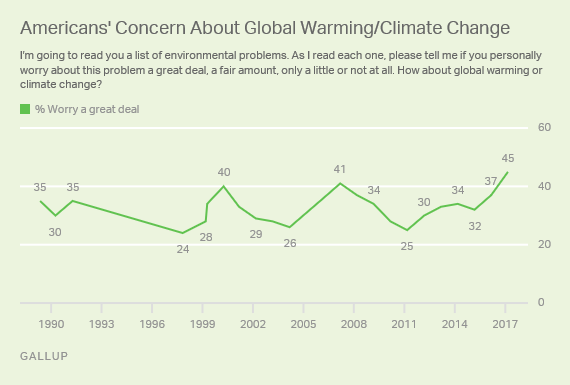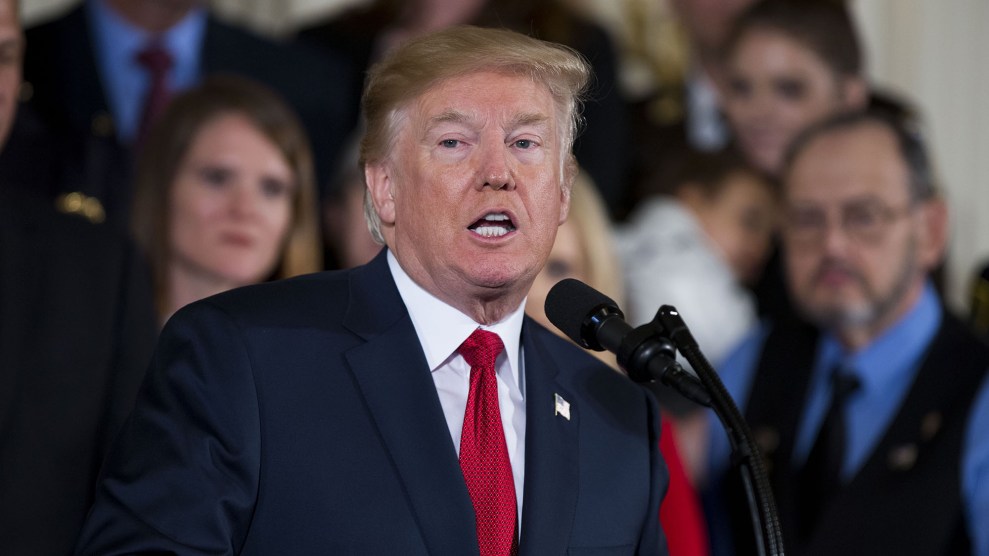
fotojog/Getty
One year ago today, Donald Trump—once just a New York billionaire famous for his orange complexion and “firing” wannabe celebrities on reality television—was elected to be the 45th president of this great land. In his first year, a lot has happened, to put it mildly. Here at Mother Jones we’ve spent a lot of time covering all the scary things over the past year (like this and this and this) but it’s important to note that it hasn’t been all bad. Really! Just last night, Progressives took home big wins in elections across the country. So on the anniversary of the end of times, we’ve collected 10 examples of what we’re calling the Positive Trump Effect.
1. People are finally paying for their news.
Yes, we realize this is a somewhat selfish one to start with. But the impact on the news is, well, big news. The day after Trump’s election, the Wall Street Journal saw a 300 percent increase in new subscribers; in the week following the election, nonprofit investigative journalism outlet ProPublica had their donations surge from 10 per day to about three every minute; within a month after the election, the New York Times added 130,000 new subscribers. In December, Trump tweeted that Vanity Fair had “really low numbers” after the magazine published an unfavorable review of Trump Grill, Trump Tower‘s steakhouse. Shortly after, Vanity Fair set a company record for subscription sales in a single day. And yes, Mother Jones also had a boost in support—from November 2016 through January 2017, MoJo saw a 160 percent increase in donations.
Has anyone looked at the really poor numbers of @VanityFair Magazine. Way down, big trouble, dead! Graydon Carter, no talent, will be out!
— Donald J. Trump (@realDonaldTrump) December 15, 2016
And despite Trump’s best efforts to paint the entire industry as full of liberal phonies, overall trust in the media is actually on the rise. Last month, a Reuters/Ipsos poll showed that 48 percent of people say they have a “great deal” or “some” confidence in the press, compared with 39 percent in November last year.
2. Donations to progressive organizations are soaring.
For organizations like the ACLU and Planned Parenthood, Trump’s election has also meant big bucks. In January, the weekend after Trump’s first attempt to enact a travel ban on citizens from a handful of majority-Muslim countries, donations to the ACLU reached $24 million. Its donations totaled more than $150 million in the 2016 fiscal year (ending in March 2017), which is more than three times its haul for the previous fiscal year. Planned Parenthood meanwhile saw a 1,000 percent surge in donations in the first four months of Trump’s presidency, according to a 2017 report by Charity Navigator. Other organizations, including the Environmental Defense Fund and the American Refugee Committee, according to the report, saw similar growth.
3. Politics is finally starting to tackle its diversity problem.
With an admitted pussy-grabber in the White House, perhaps it’s no surprise that women are more energized. But just how involved they’re getting in politics is eye-popping: According to Emerge America, a group that trains Democratic women to run for office, applications for the organization’s program rose 87 percent after Election Day. “We saw an immediate uptick in interest in our work,” Emerge president and founder Andrea Dew Steele said in a February interview with NPR. “And it has persisted through today. It’s unlike anything we’ve ever seen.” And last month, EMILY’s List, an organization that helps women get elected to public office, announced that more than 20,000 women have reached out to them since Election Day. “This is a surge of grassroots energy unlike anything we’ve ever seen,” the organization said in a statement.
The phenomenon is not just limited to women. The Victory Fund and the Victory Institute, partner organizations that train LGBTQ individuals to run for office, have trained three times as many people as they did last year—260 candidates in total. Of those trainees, 61 were on Tuesday’s ballots across the country. And Amplify, a group that trains women, people of color, young people, and LGBTQ folks to run for office, said they too had a surge in interest. More than 1,000 people came to their trainings this year, more than twice as many as last year. Sixty-one percent of its participants identify as women of color.
4. Survey says…Americans are becoming less xenophobic.
During the run-up to the election, Trump’s platform of racial intolerance struck a chord with many Americans, but not just in the way you’d expect. From November 2015 to October 2016, positive attitudes toward “Muslim people” actually rose from 53 percent to 70 percent, according to polls conducted by the Anwar Sadat Chair for Peace and Development at the University of Maryland.
Shibley Telhami of the Brookings Institute pointed out earlier this year out that this kind of shift does not happen without the help of “extraordinary events”—such as Trump’s divisive, anti-Muslim rhetoric as a presidential candidate. “Evidence suggests that during the election year, attitudes of most Americans toward Islam and Muslims improved overall precisely because Trump the candidate was seen to have the opposite view,” he wrote.
Heartening; evidence also shows Americans have reacted to Trump's assault with improved views of Islam and Muslims. https://t.co/UXDCGL3CmQ pic.twitter.com/X5qZmkR5Yo
— Shibley Telhami (@ShibleyTelhami) January 30, 2017
5. Americans are waking up to the reality of climate change.
Despite Trump’s decision to pull out of the Paris climate accord and his insistence that climate change is a “hoax,” Americans’ concern about global warming is the highest it’s been in three decades, according to a recent Gallup poll. More Americans also believe climate change is in progress and that it is caused by human activity, according to the poll.

6. More Americans are recognizing the government should be responsible for providing its citizens with healthcare.
In a poll conducted by the Pew Research Center in June, 60 percent of people surveyed said that health insurance was a “federal responsibility”—the most in nearly a decade, according to the center. Also, 33 percent of people favored “single payer” health insurance, a five percent increase from January. Experts attribute this change in public opinion to the GOP-led effort to repeal Obamacare, which, had it not failed multiple times in eight months, would have left tens of millions of Americans without health insurance.
7. Political comedy is on fire.
Comedians have always poked fun at politicians, but Trump is really the perfect comedic fodder. And audiences are eating it up. Saturday Night Live‘s last full season was its most-watched in 23 years; Stephen Colbert is back, with a 13 percent increase in viewership in early 2017, compared to the same period last year. Meanwhile, TBS’s Full Frontal With Samantha Bee premiered in February 2016, the first late night talk show hosted by a woman, with an average audience of 914,000. By the end of 2016, her show had about 1.3 million average viewers and by the time its second season aired in February, she had more than 2 million, the largest growth of any late-night show during the Trump era to-date.
"I brought you in the shower to make sure you weren’t wearing a wire, Paul." #SNL pic.twitter.com/I5wtLoDjZy
— Saturday Night Live (@nbcsnl) November 5, 2017
8. America is reading the classics again—and are making a genre of new classics.
In late July 2016, Khizr Khan, the Muslim-American father of a fallen US Army captain, posed a question to then-Republican nominee Donald Trump in a speech at the Democratic National Convention: “Have you even read the United States Constitution? I will gladly lend you my copy,” he said, pulling the book from his pocket. The statement, in response to Trump’s promises of a ban on Muslim travelers into the US and a Mexico-US border wall, made the Constitution the second bestseller on Amazon the following weekend.
Then, the day after last year’s election, sales of The Handmaid’s Tale jumped by a whopping 200 percent and made Amazon’s bestseller list. The novel is currently fifth on the list, in part because of Hulu’s recent popular television series based on the 1985 novel—but also because of the parallels readers have drawn between the book’s misogynistic dystopia and the Trump administration’s policies to curb reproductive rights.
And in January, the novel 1984 rose to the top of Amazon’s list shortly after Trump adviser Kellyanne Conway used the term “alternative facts” to explain then-Press Secretary Sean Spicer’s false statement that Trump had the “largest audience ever to witness an inauguration.” Many people compared the statement to the “newspeak” language used in the dystopian novel. 1984 is still in the top 15 books on Amazon’s bestseller list.
9. Non-politicians are getting involved in civics. Hooray democracy!
After Trump’s inauguration, the Women’s March drew more than 5 million participants across the country. The largest crowds gathered in Washington, D.C., Los Angeles, New York, and Chicago, and many of the participants had never protested before. A few months later, more than a million people joined the March for Science on Earth Day. And after Trump tried to force the travel ban on certain Muslim-majority countries, thousands of people joined protests at airports across the country. “Everybody’s pissed off, and they’re pissed off for different reasons,” said Dana Fisher, a sociologist at the University of Maryland who has studied protests, in an interview with NPR. “Trump is helping everybody to find common ground.”
https://twitter.com/nickbilton/status/822893227833376768
JFK airport #MuslimBan #NoMuslimBan #NoMuslimBanJFK #NoBanNoWall pic.twitter.com/Z2iwNdXPM1
— MoveOn (@MoveOn) January 28, 2017
10. Last but not least, never forget the legendary memes.
Remember this?
And this?
https://twitter.com/DonTrumpMemes/status/716384293547847680
And this?
— Trump Memes (@trumpmemes) August 1, 2017
And this?
Sean Spicer leaving the White House: pic.twitter.com/g3t87dUEiO
— Dessert Hummus Truther™ (@iamflyrobynfly) July 21, 2017

















